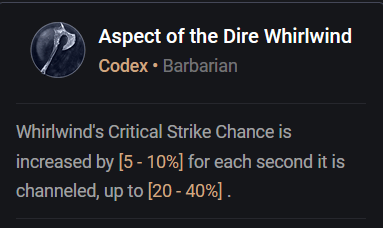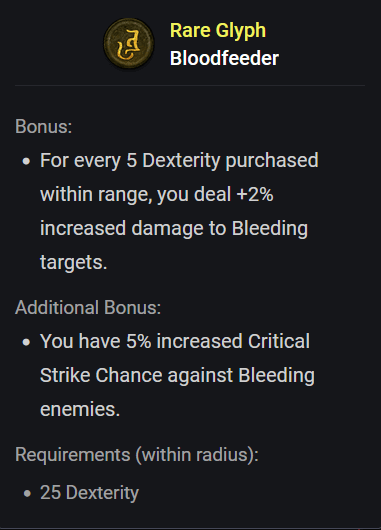The Depth of Diablo 4 Builds
There is a common idea that Diablo 4 builds are shallow and lack the ability to be highly optimized. While these claims appear to be true on the surface level, I will attempt to show that builds actually have significant amounts of space for optimization and customization. The core of my argument revolves around the idea that Diablo 4 uses many simple systems interacting to create complex builds.
The Skill Tree, Paragon Tree, Glyphs, Alchemy, class unique mechanics, stats on gear, Aspects, and Uniques are all simple to learn, and give the impression of a shallow game. However, when you consider all of these systems together you can start to see how deep builds in Diablo IV actually are.
To explain my point further, let’s take a look at the Barbarian Whirlwind build. This build can be optimized at many different levels, but there’s a very interesting problem to solve here related to your Fury generation.

The Dire Whirlwind Aspect and the Violent Whirlwind talent both offer increased damage the longer you channel Whirlwind, which encourages you to try and channel Whirlwind for as long as possible, meaning our Fury generation should come with passive effects that allow us to generate while channeling.

Some of these options include:
- Aspect of Berserk Fury: You gain 6 Fury per second while Berserking.
- Aspect of the Umbral: Restore 4 of your Primary Resource when you Crowd Control an enemy. (This is procced when our Whirlwind pulls enemies and in many other cases)
- Seething Glyph: While wielding a Sword, you gain 3 Fury when you kill an enemy
- 2H Mace Weapon Expertise: Up to a 10% chance to gain 2 Fury when hitting an enemy.
- Starlight Aspect: Gain 20 of your Primary Resource for every 20% of your Life that you Heal.
- Assimilation Aspect: You have 8% increased Dodge Chance versus enemies affected by Damage over Time Effects. When you Dodge, you gain 10 of your Primary Resource.
You can see that there are many ways from many different systems that you can use to solve this passive Fury generation problem. However, we do have the option of modifying this build to instead play with more active Fury generation, relying on upkeeping Shouts and making use of Aspect of Echoing Fury, which gives you Fury while your Shouts are active.
This will require you to regularly stop channeling Whirlwind, so you would probably opt out of the effects that give increased damage the longer you are channeling. There are so many different problems each build will encounter, and solutions to those problems can be chosen from many different systems. This leads to a very dynamic and versatile character builder where figuring out the best setup for each build is quite difficult.
Within each of these systems, there is also a lot of room for optimization. For example, let’s look at itemization, specifically how you choose which Legendary and Unique powers your build will use. Aspects have rules about which item slots they go onto, and they also have the ability to gain an increased effect based on which slot they go on. Amulets increase the effects of Aspects by 50% and 2h-weapons increase the effect by 100%.
There are also Unique items that each only roll on a specific slot with specific stats and Legendary Powers. This all leads to very competitive item slots, where you have to constantly weigh one power over another. This gets more complex when you look at the fixed stats of uniques, where sometimes it makes the item better and sometimes it makes it worse.
Depending on the gear slot you can get more damage or tankiness, resource generation or mobility, and the types of stats for each of those categories varies tremendously. This goes back to the previous point of having many different ways to solve each problem, whether it be from Items, Aspects, Paragon Tree, the Skill Tree, or wherever is best for your build.
Lastly, let’s talk about the most complex system, the Paragon Tree. For those who are not familiar, the Paragon Tree is a build-your-own skill tree where you mix and match 8 different boards to get the setup you want. Each board has Normal, Magic, and Rare Nodes as well as 1 Legendary Node and one Glyph Socket. Rare Nodes are interesting because they all have additional effects that have Core Stat requirements to unlock.
The Glyph Sockets allow you to insert a Glyph, which you collect and upgrade in Nightmare Dungeons. These Glyphs give bonuses based on surrounding nodes and then gain an additional effect when you meet the requirement. This Requirement is based on getting Core Stats from surrounding Nodes.

The Legendary Nodes are also interesting as they offer powerful bonuses and effects that often modify how your build is played. It will likely take months for each build to reach its full potential within the Paragon Tree as there is just so much variety and optimization within it, especially when you consider that you get 220 points to spend across roughly 2000 options.
The Verdict
I hope that I have demonstrated that Diablo 4 is a much deeper and more complex game than people are giving it credit for. A lot of the systems on their own are not overly complicated, but when you consider all of these systems acting in tandem builds become extremely deep. I personally have already spent dozens of hours theory crafting builds, and I cannot wait to spend more time exploring this deep and complex game.
The highly anticipated Spiritborn class will be introduced in Diablo 4’s Vessel of Hatred expansion. Get the scoop with our Spiritborn reveal.
Thanks for reading! Check out more of our Diablo 4 deep dives here.
 Download APP
Download APP Collapse
Collapse